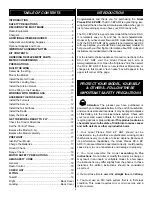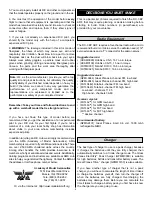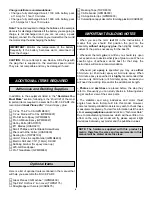
INTRODUCTION ................................................................2
SAFETY PRECAUTIONS ..................................................2
DECISIONS YOU MUST MAKE ........................................3
Radio Equipment................................................................3
Chargers.............................................................................3
ADDITIONAL ITEMS REQUIRED .....................................4
Adhesives and Building Supplies .......................................4
Optional Supplies and Tools...............................................4
IMPORTANT ASSEMBLY NOTES ....................................4
KIT CONTENTS.................................................................5
ORDERING REPLACEMENT PARTS...............................6
METRIC CONVERSIONS ..................................................6
PREPARATIONS................................................................7
BUILD THE WING ..............................................................7
Assemble the Wing ............................................................7
Mount the Motors ...............................................................8
Install the Motor Cowls.......................................................9
Install the Landing Gear .....................................................9
Install the Aileron Servos .................................................10
Fit the Wing to the Fuselage ............................................10
WORKING WITH FIBERGLASS .....................................11
ASSEMBLE THE FUSELAGE .........................................11
Install the Formers ...........................................................11
Install the Servos..............................................................12
Install the Tail Surfaces ....................................................12
Install the Radio ...............................................................14
Apply the Decals ..............................................................15
GET THE MODEL READY TO FLY..................................16
Check the Control Directions ...........................................16
Set the Control Throws.....................................................16
Balance the Model (C.G.).................................................17
Balance the Model Laterally.............................................17
PREFLIGHT .....................................................................17
Identify Your Model ...........................................................17
Charge the Batteries ........................................................17
Ground Check ..................................................................18
Range Check ...................................................................18
MOTOR SAFETY PRECAUTIONS .................................18
AMA SAFETY CODE ......................................................18
General ............................................................................18
Radio Control ...................................................................18
CHECK LIST ...................................................................19
FLYING ............................................................................19
Takeoff .............................................................................19
Flight..................................................................Back Cover
Landing..............................................................Back Cover
Congratulations and thank you for purchasing the Great
Planes DC-3 EP ARF. The DC-3 EP ARF is a great flying, low-
wing model that is about as simple-to-assemble as they get. In
just a few evenings you can have your DC-3 ready to fly.
The DC-3 EP ARF is a sport scale model of the full size DC-3.
It is relatively easy to fly and has no bad characteristics.
However, if you have never flown an R/C model before, learning
to fly the DC-3 EP ARF all by yourself is not recommended. As
with any airplane, you should find an experienced modeler to
help you with your first flights. Information about R/C clubs and
instructors is provided later in this manual.
For the latest technical updates or manual corrections to the
DC-3 EP ARF visit the Great Planes web site at
www.greatplanes.com. Open the “Airplanes” link, then select
the DC-3 EP ARF. If there is new technical information or
changes to this model a “tech notice” box will appear in the
upper left corner of the page.
Attention: The product you have purchased is
powered by a rechargeable battery. At the end of its useful life,
under various state and local laws, it may be illegal to dispose
of this battery into the municipal waste system. Check with
your local solid waste officials for details in your area for
recycling options or proper disposal.This product contains a
chemical known to the state of California to cause cancer
and birth defects or other reproductive harm.
1. Your Great Planes DC-3 EP ARF should not be
considered a toy, but rather a sophisticated, working model
that functions very much like a full-size airplane. Because of
its performance capabilities, the Great Planes DC-3 EP
ARF, if not assembled and operated correctly, could possibly
cause injury to you or spectators and damage to property.
2. You must assemble the model according to the
instructions. Do not alter or modify the model, as doing so
may result in an unsafe or unflyable model. In a few cases
the instructions may differ slightly from the photos. In those
instances the written instructions should be considered
as correct.
3. You must take time to assemble straight, true and strong.
4. You must use an R/C radio system that is in first-class
condition. This model requires mini or micro servos and a
micro receiver.
PROTECT YOUR MODEL, YOURSELF
& OTHERS...FOLLOW THESE
IMPORTANT SAFETY PRECAUTIONS
INTRODUCTION
TABLE OF CONTENTS
2



































